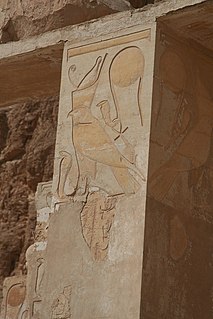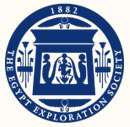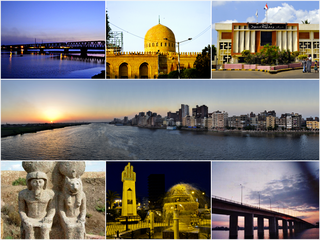In Egyptian history, the Upper and Lower Egypt period was the final stage of prehistoric Egypt and directly preceded the nation's unification. The conception of Egypt as the Two Lands was an example of the dualism in ancient Egyptian culture and frequently appeared in texts and imagery, including in the titles of Egyptian pharaohs.

Wadjet, known to the Greek world as Uto or Buto among other names including Wedjat, Uadjet, and Udjo, was originally the ancient local goddess of the city of Dep. It became part of the city that the Egyptians named Per-Wadjet and the Greeks called Buto, which was an important site in prehistoric Egypt and the cultural developments of the Paleolithic. There was also a Per-Wadjet in Upper Egypt.

Buto, Butus, or Butosus, now Tell El Fara'in, near the villages of Ibtu and Kom Butu and the city of Desouk, are names later given to an ancient city located 95 km east of Alexandria in the Nile Delta of Egypt. What in Classical times the Greeks called Buto stood about midway between the Taly (Bolbitine) and Thermuthiac (Sebennytic) branches of the Nile, a few kilometers north of the east-west Butic River and on the southern shore of the Butic Lake.

The Egypt Exploration Society (EES) is a British non-profit organization. The society was founded in 1882 by Amelia Edwards and Reginald Stuart Poole in order to examine and excavate in the areas of Egypt and Sudan. The intent was to study and analyze the results of the excavations and publish the information for the scholarly world. The EES have worked at many major Egyptian excavation and sites. Their discoveries include the discovery of a shrine for the goddess Hathor, a statue of a cow from Deir el-Bahri, the mortuary temple of Queen Hatshepsut, and the sculpted model of Nefertiti from Amarna. The Society has made major contributions to the study of the ancient Egyptian world. The Society is based in London and is a registered charity under English law.

The Second Dynasty of ancient Egypt is the latter of the two dynasties of the Egyptian Archaic Period, when the seat of government was centred at Thinis. It is most known for its last ruler, Khasekhemwy, but is otherwise one of the most obscure periods in Egyptian history.

Djer is considered the third pharaoh of the First Dynasty of ancient Egypt in current Egyptology. He lived around the mid-thirty-first century BC and reigned for c. 40 years. A mummified forearm of Djer or his wife was discovered by Flinders Petrie, but was discarded by Émile Brugsch.

Shepsesre Tefnakht was a prince of Sais and founder of the relatively short Twenty-fourth dynasty of Egypt; he rose to become a Chief of the Ma in his home city. He is thought to have reigned roughly 732 BCE to 725 BCE, or 7 years. Tefnakht I first began his career as the "Great Chief of the West" and Prince of Sais and was a late contemporary of the last ruler of the 22nd dynasty: Shoshenq V. Tefnakht I was actually the second ruler of Sais; he was preceded by Osorkon C, who is attested by several documents mentioning him as this city's Chief of the Ma and Army Leader, according to Kenneth Kitchen, while his predecessor as Great Chief of the West was a man named Ankhhor. A recently discovered statue, dedicated by Tefnakht I to Amun-Re, reveals important details about his personal origins. The statue's text states that Tefnakht was the son of a certain Gemnefsutkapu and the grandson of Basa, a priest of Amun near Sais. Consequently, Tefnakht was not actually descended from either lines of Chiefs of the Ma and of the Libu as traditionally believed but rather came from a family of priests, and his ancestors being more likely Egyptians rather than Libyans.

Deshret, from Ancient Egyptian, was the formal name for the Red Crown of Lower Egypt and for the desert Red Land on either side of Kemet, the fertile Nile river basin. When combined with the Hedjet of Upper Egypt, it forms the Pschent, in Ancient Egyptian called the sekhemti.

Desouk is a city in northern Egypt. Located 80 km east of Alexandria, in the Kafr El Sheikh Governorate and had a population of 137,660 inhabitants as of 2011. It is bordered to the west by the Beheira Governorate.

Nefaarud I or Nayfaurud I, better known with his hellenised name Nepherites I, was an ancient Egyptian pharaoh, the founder of the 29th Dynasty in 399 BC.
Hermopolis also known as Hermopolis Mikra and Hermopolis Parva was an ancient city of Egypt. It was located on an island near the city Butosos now Buto.
Scorpion I was the first of two rulers of Upper Egypt with that name, during Naqada III. His name may refer to the scorpion goddess Selket, though evidence suggests Selket's rise in popularity to be in the Old Kingdom, bringing doubt to whether Scorpion actually took his name from her. He was one of the first rulers of Ancient Egypt.

Kafr El Sheikh Governorate is one of the governorates of Egypt. It lies in the northern part of the country, along the western branch of the Nile in the Nile Delta. Its capital is the city of Kafr El Sheikh.

The Souls of Pe and Nekhen, mentioned first in the Pyramid Texts, refer to the ancestors of the ancient Egyptian kings. Nekhen was the Upper Egyptian centre of the worship of the god Horus, whose successors the Egyptian pharaohs were thought to be. Pe was a Lower Egyptian town, not known for its Horus worship, but Ra had awarded the town to Horus after his eye was injured in the struggle for the throne of Egypt.
Veronica (Marjory) Seton-Williams, was a British-Australian Archaeologist who excavated in Egypt and the Near East. She studied history and political science at the University of Melbourne and then Egyptology and Prehistory at University College London.

Payeftjauemawyneith or Peftuaneith was an Ancient Egyptian high official who lived during the 26th Dynasty, serving under the kings Apries and Amasis. He is known from several monuments providing evidence for his importance.
The Diocese of Buto is a former Christian diocese and titular see of both the Roman Catholic and Coptic Orthodox Churches, with see in the Ancient City of Buto in the Nile Delta of Egypt.
Dorothy Charlesworth (1927–1981) was a Roman archaeologist and glass specialist who served as Inspector of Ancient Monuments. She worked within Britain and Egypt.











